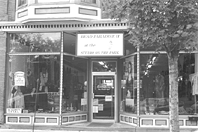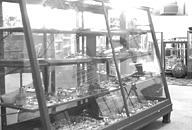

Artfully arranged in the store window of Bead Paradise II at the Studio on the Park are a pair of vintage eyeglass frames, an amber necklace, several Peruvian flutes, a bracelet made in Yemen, three pots of flowers and a rice paper parasol.
When store owner Ruth Aschaffenburg first went into business 12 years ago, by contrast, she only sold beads. The space she then rented on the upper floor of the old Co-op bookstore measured a mere 250 square feet.
In 1992, Aschaffenburg bought Studio on the Park, a women's clothing store. She combined it with her existing business, and Bead Paradise at the Studio on the Park was born. In May 1998, she moved the store to its current address on West College Street.
"I really love this building; I'd always wanted it," she said of the space, which dates from 1912 and still boasts its original tin ceilings.

At over 6,000 square feet, the building is much larger than the store's two previous homes. Dream Closet, a vintage clothing store, sublets the basement level, and much of the second floor is used as an office.
The ample space has allowed Aschaffenburg to add new items to her inventory, ranging from natural toiletries to imported drums.
Last April, the store also added a new room devoted to student oriented goods.
"In terms of style and cost, most of the clothing downstairs is not aimed at students," Aschaffenburg said. "Students do buy the clothing sometimes, but usually for special occasions - concerts, weddings, funerals. The upstairs area is more geared toward everyday items."
Among the items upstairs are the store's sale merchandise, as well as vintage clothes and jewelry, incense, candles, Indian tapestries and relatively inexpensive import clothing - including a rack of African dresses made by her husband's family in the Gambia.

Although clothing sales bring in most of the store's revenue, jewelry remains Aschaffenburg's passion.
Born and raised in Oberlin, she first began beading in junior high school. When she was twelve, she attended an auction on East College Street and paid a quarter for a box of what later turned out to be valuable old beads. "That was really the start of it all," she said.
After graduating from the Oberlin college of arts and sciences with a degree in English in 1981, Aschaffenburg left the area for several years, but eventually returned and opened Bead Paradise in 1987.
The store has since developed into an informal community center for professional jewelry designers in northern Ohio, and hosts the regional bead guild's meetings every other month.
While Bead Paradise II does not offer classes, Aschaffenburg and her seven employees, four of whom are students at the College, help teach customers beading techniques and offer free advice.
"Every day several people come in and need help learning to bead from the very beginning," she said.
A large wooden table and chairs are provided for customers to use while beading, as are pliers, wire cutters and instructional books.
"It really is an addictive hobby," said Aschaffenburg of beading. "That's why people keep coming back."
Her own love affair with beading spilled over into her personal life when, several years ago, she began dating Ebrima Sillah, her main African bead supplier. Today they are married, and Aschaffenburg has made five trips to Africa to visit Sillah's family in the Gambia in addition to buying beads.
She also travels regularly to New York, Los Angeles and Seattle to buy goods for the store and hopes to enter the wholesale business within the next 10 years.
"A lot of people have invested their money in stocks and bonds," Aschaffenburg said. "I've invested in beads."
Paradise for beaders: This quaint store houses clothing as well as beads and a vintage clothing store. (photos by Monica Schneider)
On display: The merchandise at Bead Paradise includes antique and rare beads.
Copyright © 1999, The Oberlin Review.
Volume 128, Number 4, September 24, 1999
Contact us with your comments and suggestions.